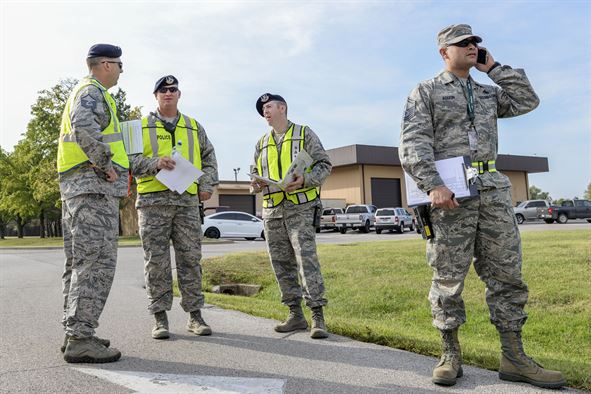SCOTT AIR FORCE BASE, Ill. — The 375th Inspector General Office conducted an active shooter exercise Sept. 21 at Scott to assess the 375th Air Mobility Wing’s notification, response, and incident command and control procedures.
Mission partners—including the 126th Air Refueling Wing, 932nd Airlift Wing, Defense Information Systems Agency, U.S. TRANSCOM, and the Air Force Network Integration Center—joined this effort to test their own notification and response procedures in the event of an active shooter incident.
During the exercise, the 375th IG reviewed appropriate Air Force Instructions, along with associated installation plans. They developed and exercised a scenario that validated actual plans, policies, procedures, processes, and doctrine while using existing command, control and communications systems.
“Training and exercises are the best activities to help prepare personnel to react quickly and effectively in any emergency situation,” said Charlie Mills, 375th IG. “In the midst of the chaos, anyone can play an integral role in mitigating the impacts of an active shooter incident. Our aim is to enhance awareness and to help people understand the need to prepare for and respond to an active shooter incident.”
Members from the Wing Inspection Team, who are designated by their commanders, evaluated the mission of their units. WIT members look at the specific role their unit plays in the mission and make sure they are performing their actions correctly, said Tech. Sgt. Daniel Baker, 375th SFS WIT evaluator.
“Each unit handles (the) exercise to see what their goal is in these missions, but getting the whole wing together and interacting really adds that extra layer of realism to these exercises,” said Baker. “This gives us the opportunity to get all of the players together and see what each of us does, see if there is an overlap, and if there is any room for improvement. It also opens up lines of communication so if we face this situation in the real world, everyone will be ready.”
The 375th SFS was the first unit to respond during the exercise, which involved eliminating the threat, clearing the building, caring for casualties, and getting medical and firefighters on the scene.
Capt. Christopher Gresham, 375th SFS, said there are two objectives during an active shooter: Take down the threat and evacuate casualties. Gresham was pleased with how the exercise was executed.
“With the controlled chaos aspect of an active shooter there are always going to be things that go wrong,” said Gresham. “If those two objectives are met, which they were, then it’s a good exercise. I think we did fantastic because we got those guys out in about 15 minutes.”
Mills said real-life active shooters are unpredictable as far as when and where it will happen, and that these situations evolve very quickly. He added that it is imperative all personnel, including family members, know and understand how to respond correctly to an active shooter incident. Also, being prepared and having the necessary knowledge can save lives.
Furthermore, Mills said, there is no definitive best response during these scenarios, but maintaining a run, hide, and fight mindset can increase the odds of surviving. Remembering that personal safety is the primary consideration in any emergency—along with helping others to safety—increases the survivability for all potential victims.
If the active shooter is in a workplace’s vicinity, running and evacuating is the first step and includes having an escape route and plan in mind. While helping others escape and avoid an area where the shooter may be present is encouraged, it’s also imperative to evacuate—whether or not others agree to follow. At all times, peoples’ hands should remain visible, and if first responders aren’t already on the premises, it’s critical to call 911 when safe.
If evacuation is not possible, people should find a hideout that does not restrict their options for movement but keeps them out of the shooter’s view. Additionally, individuals should provide protection from shots fired in their direction, whether it be a locked door or one blockaded with heavy furniture. Those in danger should remain quiet, silence cell phones, and dial 911 to alert dispatchers of their location. If unable to speak, leave the dispatcher on the line.
As a last resort—and only when a person’s life is in immediate danger—attempt to disrupt or incapacitate the active shooter by yelling, throwing items, improvising weapons, and committing to those actions.
“Units with active training and education programs that include all personnel are better prepared to respond effectively to the many different situations that could place them in danger,” said Mills. “Commanders and facility managers working with Law Enforcement and Emergency Management can ensure all assigned personnel are better prepared to respond and react to an active shooter incident by ensuring people know what their individual responsibilities are in this type of a situation.”


